B1U2读写教案
PEP四年级上册U2B1简案
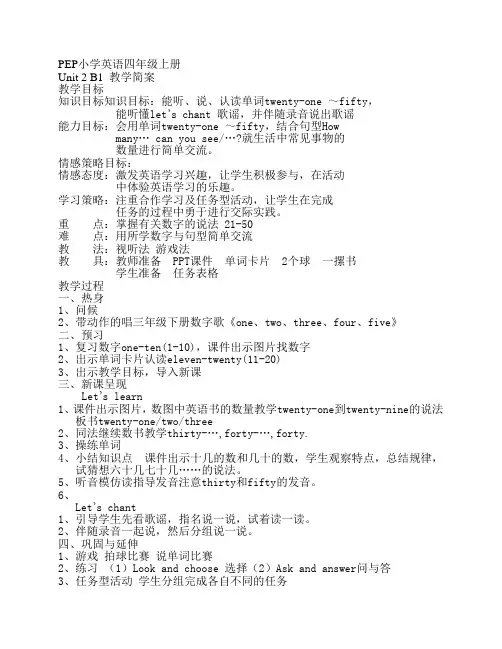
PEP小学英语四年级上册Unit 2 B1 教学简案教学目标知识目标知识目标:能听、说、认读单词twenty-one ~fifty,能听懂let’s chant 歌谣,并伴随录音说出歌谣能力目标:会用单词twenty-one ~fifty,结合句型Howmany… can you see/…?就生活中常见事物的数量进行简单交流。
情感策略目标:情感态度:激发英语学习兴趣,让学生积极参与,在活动中体验英语学习的乐趣。
学习策略:注重合作学习及任务型活动,让学生在完成任务的过程中勇于进行交际实践。
重点:掌握有关数字的说法 21-50难点:用所学数字与句型简单交流教法:视听法游戏法教具:教师准备 PPT课件单词卡片 2个球一摞书学生准备任务表格教学过程一、热身1、问候2、带动作的唱三年级下册数字歌《one、two、three、four、five》二、预习1、复习数字one-ten(1-10),课件出示图片找数字2、出示单词卡片认读eleven-twenty(11-20)3、出示教学目标,导入新课三、新课呈现Let’s learn1、课件出示图片,数图中英语书的数量教学twenty-one到twenty-nine的说法板书twenty-one/two/three2、同法继续数书教学thirty-…,forty-…,forty.3、操练单词4、小结知识点课件出示十几的数和几十的数,学生观察特点,总结规律,试猜想六十几七十几……的说法。
5、听音模仿读指导发音注意thirty和fifty的发音。
6、Let’s chant1、引导学生先看歌谣,指名说一说,试着读一读。
2、伴随录音一起说,然后分组说一说。
四、巩固与延伸1、游戏拍球比赛说单词比赛2、练习(1)Look and choose 选择(2)Ask and answer问与答3、任务型活动学生分组完成各自不同的任务五、板书设计(详见黑板)六、附学生任务活动表如下Task1How many Gold(金), Silver(银)and Bronze(铜)medal(奖牌)did we get in The Olympic(奥林匹克)Games in 2012 ?Tips(任务提示): Y ou can search on line(网搜)Task2How many books are there on teacher’s desk?Tips(任务提示):2students count(数)1student write down.(记录)Task3How old is your partner(搭档)’s father and grandparents?Tips(任务提示):Ask each other in English and then write down(互相用英文问答并做好记录)Task4How many Chinese,math English classes and…(课) do you have in a week ? Tips(任务提示): 1student count 1subject (1人查一科)Task5How many words can you say in 1 minute(分钟) ?Tips(任务提示):1 student says English words,1 student count and another watch the time.Task6How old is our visiter Mr.Zhang/…and Miss Li/…Tips(任务提示):Choose some visiter to ask their family name and age politely. (选择几个客人询问他们姓什么及年龄,要有礼貌)。
新版六年级英语上册unit2B部分let's learn ,Read and write教案
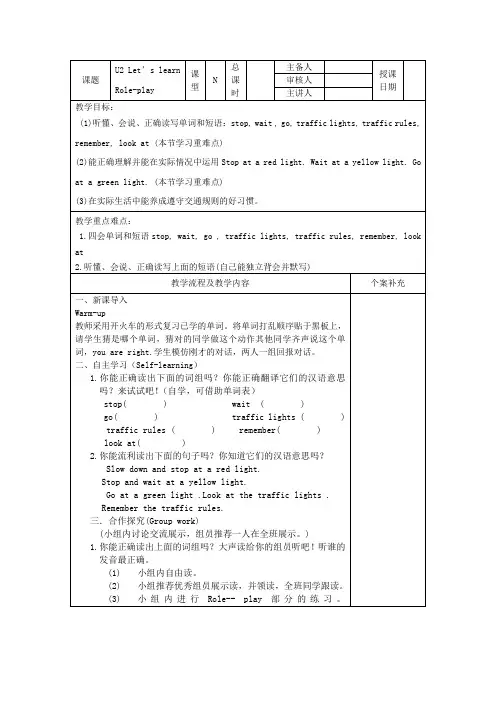
2.你能用英语写出下面的句子吗?红灯停,绿灯行,黄灯亮了等一等。
_____________________________________________________ _____________________________________________________小组展示(Group show)对合作探究中的两个问题进行展示。
巩固延伸(Consolidation and extension)你认识下面的标志吗?四、点拨释疑1.slow down 慢下来固定短语, .2.traffic rules 是traffic rule的复数形式,traffic lights是traffic light的复数形式,在实际运用中要正确使用复数。
3.Chant:Red light,red light,stop stop stop;Yellow light,yellow light,wait wait wait;Green light,green light ,go go go.五、当堂测评一、填空1、()at a red light.2、() at a yellow light.3、() at a green light.二、翻译词组1、在那边2、交通灯3、咱们走吧三、连词成句1、traffic lights the at look ____________________________2、 the traffic rules remember ____________________________六、课堂盘点我认识交通的标志作业设计:Slow down and stop at a red light.2.Stop and wait at a yellow light.3.Go at a green light.板书设计:u2 let’s learnSlow down and stop at a red light.Stop and wait at a yellow light.Go at a green light。
英语六年级上册 U2 B教案
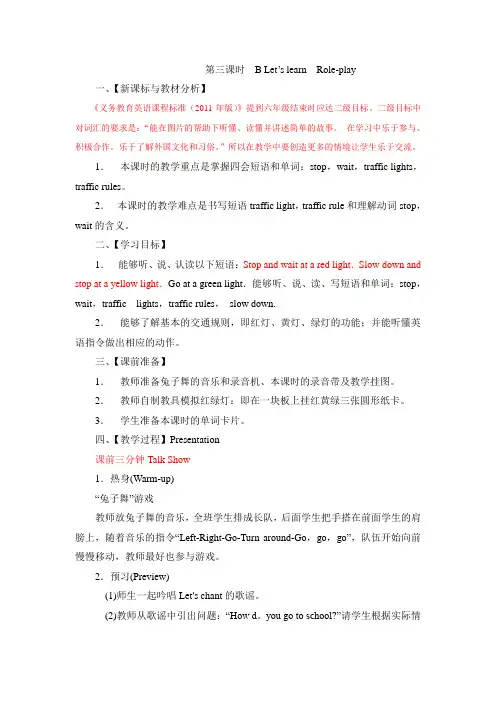
第三课时 B Let’s learn Role-play一、【新课标与教材分析】《义务教育英语课程标准(2011年版)》提到六年级结束时应达二级目标。
二级目标中对词汇的要求是:“能在图片的帮助下听懂、读懂并讲述简单的故事。
在学习中乐于参与、积极合作。
乐于了解外国文化和习俗。
”所以在教学中要创造更多的情境让学生乐于交流。
1.本课时的教学重点是掌握四会短语和单词:stop,wait,traffic lights,traffic rules。
2.本课时的教学难点是书写短语traffic light,traffic rule和理解动词stop,wait的含义。
二、【学习目标】1.能够听、说、认读以下短语:Stop and wait at a red light.Slow down and stop at a yellow light.Go at a green light.能够听、说、读、写短语和单词:stop,wait,traffic lights,traffic rules,slow down.2.能够了解基本的交通规则,即红灯、黄灯、绿灯的功能;并能听懂英语指令做出相应的动作。
三、【课前准备】1.教师准备兔子舞的音乐和录音机、本课时的录音带及教学挂图。
2.教师自制教具模拟红绿灯:即在一块板上挂红黄绿三张圆形纸卡。
3.学生准备本课时的单词卡片。
四、【教学过程】Presentation课前三分钟Talk Show1.热身(Warm-up)“兔子舞”游戏教师放兔子舞的音乐,全班学生排成长队,后面学生把手搭在前面学生的肩膀上,随着音乐的指令“Left-Right-Go-Turn around-Go,go,go”,队伍开始向前慢慢移动,教师最好也参与游戏。
2.预习(Preview)(1)师生一起吟唱Let's chant的歌谣。
(2)教师从歌谣中引出问题:“How d。
you go to school?”请学生根据实际情况回答,复习A部分主要句型。
U2T1B教案模板
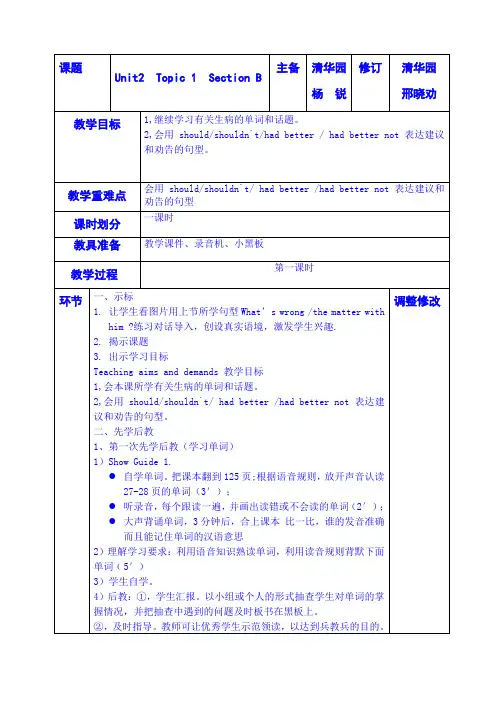
课题Unit2 Topic 1 Section B主备清华园杨锐修订清华园邢晓劝教学目标1,继续学习有关生病的单词和话题。
2,会用should/shouldn`t/had better / had better not 表达建议和劝告的句型。
教学重难点会用should/shouldn`t/ had better /had better not 表达建议和劝告的句型课时划分一课时教具准备教学课件、录音机、小黑板教学过程第一课时环节一、示标1. 让学生看图片用上节所学句型What’s wrong /the matter withhim ?练习对话导入,创设真实语境,激发学生兴趣.2. 揭示课题3. 出示学习目标Teaching aims and demands 教学目标1,会本课所学有关生病的单词和话题。
2,会用should/shouldn`t/ had better /had better not 表达建议和劝告的句型。
二、先学后教1、第一次先学后教(学习单词)1)Show Guide 1.●自学单词。
把课本翻到125页;根据语音规则,放开声音认读27-28页的单词(3′);●听录音,每个跟读一遍,并画出读错或不会读的单词(2′);●大声背诵单词,3分钟后,合上课本比一比,谁的发音准确而且能记住单词的汉语意思2)理解学习要求:利用语音知识熟读单词,利用读音规则背默下面单词﹙5′)3)学生自学。
4)后教:①,学生汇报。
以小组或个人的形式抽查学生对单词的掌握情况,并把抽查中遇到的问题及时板书在黑板上。
②,及时指导。
教师可让优秀学生示范领读,以达到兵教兵的目的。
调整修改5)强化训练。
Class erercise(1)1)说出红色单词的发音及汉语意思。
(2′)1,You look pale( )2,I`m feeling terrible.( )3,You should`t eat so much candy.( )4,You should brush( ) your teeth( ) twice a day. 5,You should take good care of ( ) your eyes.2. 第二次先学后教﹙学习课文1a﹚1, Show Guide 2.1),打开课本,先读文中插图,感知图画内容,然后大声自读27页1a,不会读的画横线;(2′)2),用手指指着课文,仔细听不会读的地方,并跟读,争取读准每个句子;(3′)3),参照课后109页的注释,口头翻译课文,并圈出不理解的句子,先小组交流,后集体解决。
新视野大学英语第三版读写教程第一册 Quiz B1U2
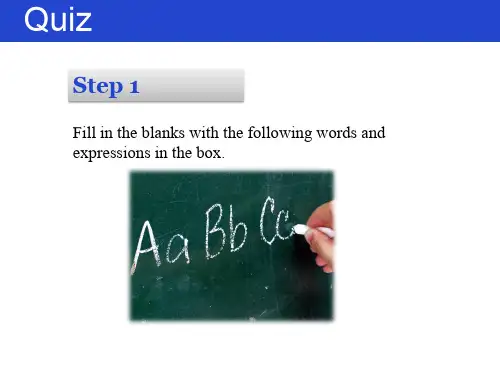
2019/1n the blanks with the following words and expressions in the box.
Quiz
curb embarrassed efficiency emotional donation
1) Thanks to the
of air transport,
Quiz
curb embarrassd efficiency emotional donation
4) He was
when he discovered that he didn't have
enough money to pay for the red wine he had ordered.
5) The new system designed to harmful emissions (排放物) from factories will be put into use soon.
the competitive event if the result is only to prove how incompetent you are?
Quiz
keep back free of/from make it After all throw away
8) A lot of what we
10) We want to give all children a world
violence.
Quiz
Step 2
1. Gradually it evolved into a religious as well as secular (非 宗教的 ) celebration, celebrated by an increasing number of non-Christians. 2. To small children, the festival is full of fantasy and surprise. 3. Today Christmas is observed as an important festival and public holiday around the world. 4. 中秋节也是家庭团圆的时刻。 5. 中秋节的习俗很多,都寄托着人们对美好生活的热爱和向往。
B1U2 reading 教学案
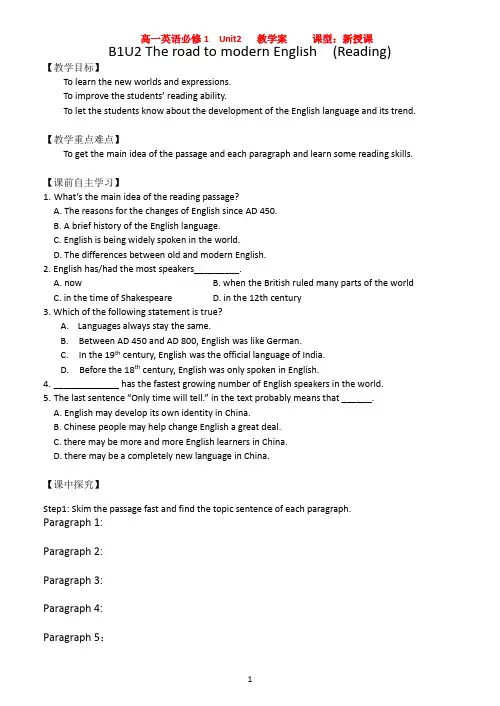
高一英语必修1 Unit2 教学案课型:新授课B1U2 The road to modern English (Reading)【教学目标】To learn the new worlds and expressions.To improve the students’ reading ability.To let the students know about the development of the English language and its trend. 【教学重点难点】To get the main idea of the passage and each paragraph and learn some reading skills. 【课前自主学习】1.What’s the main idea of the reading passage?A. The reasons for the changes of English since AD 450.B. A brief history of the English language.C. English is being widely spoken in the world.D. The differences between old and modern English.2. English has/had the most speakers_________.A. nowB. when the British ruled many parts of the worldC. in the time of ShakespeareD. in the 12th century3. Which of the following statement is true?nguages always stay the same.B. Between AD 450 and AD 800, English was like German.C. In the 19th century, English was the official language of India.D. Before the 18th century, English was only spoken in English.4._____________ has the fastest growing number of English speakers in the world.5.The last sentence “Only time will tell.” in the text probably means that ______.A. English may develop its own identity in China.B. Chinese people may help change English a great deal.C. there may be more and more English learners in China.D. there may be a completely new language in China.【课中探究】Step1: Skim the passage fast and find the topic sentence of each paragraph. Paragraph 1:Paragraph 2:Paragraph 3:Paragraph 4:Paragraph 5:高一英语必修1 Unit2 教学案课型:新授课【课堂即练】根据课文内容完成下面语法填空。
新视野大学英语b1u2_教案
课时:2课时教学对象:大学英语B1水平的学生教学目标:1. 理解文章主旨大意,掌握文章结构和段落发展手法;2. 掌握并运用文章中的重点词汇和语法结构;3. 培养学生的阅读技巧,提高阅读速度和理解能力;4. 培养学生的写作能力,学会撰写不同类型的文章。
教学重点:1. 理解文章主旨大意,分析文章结构和段落发展手法;2. 掌握并运用文章中的重点词汇和语法结构;3. 提高学生的阅读速度和理解能力。
教学难点:1. 理解并运用文章中的复杂句型;2. 学会撰写不同类型的文章。
教学准备:1. 教师准备:新视野大学英语B1U2教材、多媒体课件、教学活动设计;2. 学生准备:预习教材,了解文章背景知识。
教学过程:第一课时一、导入1. 回顾上一节课的内容,检查学生对上一节课知识的掌握情况;2. 引导学生思考:如何提高阅读速度和理解能力?二、新课导入1. 介绍文章背景知识,激发学生学习兴趣;2. 学生自由朗读课文,找出文章中的生词和难句,教师进行讲解。
三、阅读教学1. 阅读理解:(1)学生快速阅读文章,了解文章大意;(2)教师提问,检查学生对文章主旨大意的理解;(3)学生细读文章,分析文章结构和段落发展手法;(4)教师讲解文章中的重点词汇和语法结构;(5)学生练习阅读理解题,巩固所学知识。
2. 阅读技巧:(1)讲解如何提高阅读速度;(2)引导学生运用阅读技巧,提高阅读理解能力。
四、课堂小结1. 回顾本节课所学内容;2. 布置课后作业。
第二课时一、复习导入1. 回顾上一节课的内容,检查学生对上一节课知识的掌握情况;2. 引导学生思考:如何运用所学知识撰写不同类型的文章?二、写作教学1. 讲解不同类型文章的写作方法和技巧;2. 学生分组讨论,根据所学知识撰写不同类型的文章;3. 教师指导,帮助学生修改文章,提高写作水平。
三、课堂小结1. 回顾本节课所学内容;2. 布置课后作业。
教学评价:1. 学生对文章主旨大意、结构和段落发展手法的理解;2. 学生对文章中重点词汇和语法结构的掌握程度;3. 学生阅读速度和理解能力的提高;4. 学生写作能力的提升。
小学六年级英语 U2 B1《the Natural World》教学设计
Teaching Designs of Part B1 in the Natural World《the Natural World》B1部分教学设计Teaching objectives:1.Learn when and how to use the superlative degree.2.Be able to use the sentence structure: “What is the longest river inChina? The longest river in China is the Changjiang River.”3.Be able to talk about special places in Shenzhen.Key points:Learn when and how to use the superlative degree.Difficult point:Learn how to talk about special places in a city.Teaching tools:1.digital white board2.tablet computer3.teaching software4.short videosTeaching Process:places in Shenzhen to prepare a special trip to the characters.)Ask the students to create and act out how the director and the workers discuss the special places in Shenzhen.Shenzhen. Step5 Sum up Sum up what have been learned with the students.Sum up what have been learned with the teacher.Step6 Homework1. Finish the conversation by yourself.2. Find more information about the “~est” in Shenzhen, China or the world.1. Finish the conversation by yourself.2. Find more information about the “~est” in Shenzhen, China or the world.小学英语深港版第十一册《The Natural World 》B1课前习1. Watch and take notes. Class :Name :①Luo is _________than Zhang.②Huang is _______than Luo and Zhang. ③Huangis the________ of the three. ④Sun is _______ than Luo, Zhang and Huang. ⑤Sun is the________ of the four. ⑥Lei is ________ than Luo, Zhang, Huang and Sun. ⑦Lei is the_________of the five. ⑧Wang is ______ than Luo, Zhang, Huang, Sun and Lei. ⑨Wang is the__________ of the six. ⑩Sun is_______ than Luo, Lei, Huang, Wang and Zhang. ⑪Sun is the _________ of the six. ⑫Zhang is _______ than Luo, Wang, Huang, Sun and Lei. ⑬Zhang is the _________ of the six. 2. Think and circle.heavier 更重/最重 taller 更高/最高 younger 更年轻/最年轻 heaviest 更重/最重 tallest 更高/最高 youngest 更年轻/最年轻 longest 更长/最长 largest 更大/最大 highest 更高/最高 Family Weight HeightAgeFatherkgcmyears old766618778k 171717176174523444Sun Z L Hua L WaWho is the heaviest in your family? ________________ is/am the heaviest in my family. Who is the tallest in your family? ________________ is/am the tallest in my family. Who is the youngest in your family? ________________ is/am the youngest in my family.4.Search and write.Please write about more “~est” in Shenzhen and find some pictures of the places.Eg. The longest road in Shenzhen is Shennan Road.The largest theme park in Shenzhen is _________. You can _____________________________. The highest mountain in Shenzhen is _________. You can ______________________________. (the biggest/ the busiest/ the nicest/ the tallest/ the oldest/ the funniest/the smallest…)_______________________________________________________________________________ __________________________________________________________________________________________。
选必B1U2-第5课时-Presenting ideas
To help studentsbuild the basic structure of an argumentation and some DOS and Don’ts.
教学目标
在本板块学习结束时,学生能够:
1.更深入理解坚韧不拔的毅力、不屈不饶的精神对于成功的必要性,能够辩证地看待问题,另辟蹊径,思考解决问题的办法;
2.熟悉辩论的流程,并运用本单元所学的表达方式,恰当表达自己的观点,有理有据地进行辩论;
3.利用辩论技巧和程式书写一篇简短的议论文。
教学重点
1.引导学生对人生挫折与如何面对挫折这一话题进行更深入的理解,并恰当地运用本单元所学内容与同学协作进行辩论;
境看作是新的机遇和挑战,树立“勇往直前,永不放弃”的人生态度;能够通过运用各种学习策略,在自主、合作与探究式学习的过程中,结合单元提供的反思性和评价性问题,不断监控、评价、反思和调整自己的学习内容和进程,激发学习英语的兴趣,提高分析和解决问题的能力,
提高自己的理解能力和表达能力,最终促进自身语言能力、文化意识、思维品质和学习能力的综合提升。
单元目标
学生能够围绕本单元的主题语境内容,基于单元提供的诗歌、对话、日记、图表、散文等多模态语篇,综合运用各种语言技能,读懂本单元介绍人生经历、人物品质及人生态度的相关话题,听懂并谈论日常生活中对他人的遭遇表达关切与安慰的相关话题,恰当使用所学词汇与表达描
述和介绍人物生平,讲述人物故事及自身经历,了解中外优秀人物的精神品质,学会做人做事,深化对单元主题意义的理解;能够运用单元所学知识,通过比较、分析并联系自身实际,有逻辑地与他人分享亲身经历,实现知识和思维能力的拓展与迁移;能够多维度地看待事物,将困
大学英语b1u2_教案
一、课题大学英语B1U2二、教学目的1. 帮助学生掌握本单元的核心词汇和短语。
2. 提高学生的阅读理解能力,能够理解并分析文章的主旨和细节。
3. 培养学生的写作能力,能够运用所学词汇和语法知识撰写短文。
4. 增强学生的口语表达能力,能够就本单元主题进行讨论。
三、课型综合课四、课时2课时五、教学重点1. 词汇:掌握本单元的核心词汇和短语。
2. 阅读理解:理解文章的主旨和细节。
3. 写作:运用所学词汇和语法知识撰写短文。
4. 口语表达:就本单元主题进行讨论。
六、教学难点1. 词汇的记忆和应用。
2. 阅读理解的技巧和方法。
3. 写作中语法结构的正确运用。
4. 口语表达中的流畅性和准确性。
七、教学过程第一课时(一)导入新课1. 利用图片、视频等媒体展示本单元主题,激发学生学习兴趣。
2. 通过提问,引导学生回顾上节课所学内容。
(二)词汇教学1. 介绍本单元核心词汇,如:preference, diverse, essential, incorporate, etc.2. 通过例句和练习,帮助学生理解词汇含义和用法。
3. 组织词汇游戏,巩固词汇记忆。
(三)阅读理解1. 预览文章,了解文章大意。
2. 分组讨论,分析文章结构和段落大意。
3. 逐段阅读,解答问题,加深对文章的理解。
(四)小结1. 总结本节课所学内容。
2. 布置课后作业。
第二课时(一)复习上节课内容1. 回顾核心词汇和短语。
2. 检查学生的阅读理解能力。
(二)写作指导1. 分析本单元主题,确定写作思路。
2. 指导学生运用所学词汇和语法知识撰写短文。
3. 学生练习写作,教师个别指导。
(三)口语表达1. 分组讨论,就本单元主题进行交流。
2. 模拟情景,进行口语练习。
3. 学生展示,教师点评。
(四)小结1. 总结本节课所学内容。
2. 布置课后作业。
八、板书设计1. 核心词汇:preference, diverse, essential, incorporate, etc.2. 阅读理解技巧:主旨大意、段落大意、细节理解。
- 1、下载文档前请自行甄别文档内容的完整性,平台不提供额外的编辑、内容补充、找答案等附加服务。
- 2、"仅部分预览"的文档,不可在线预览部分如存在完整性等问题,可反馈申请退款(可完整预览的文档不适用该条件!)。
- 3、如文档侵犯您的权益,请联系客服反馈,我们会尽快为您处理(人工客服工作时间:9:00-18:30)。
• But it's them--they know 但那是别人,是他 但那是别人, 们追求的生活 • Not me. Now there's a way, and I know 不 是我, 是我,现在我知道该怎么做了 • That I have to go away 我会离开你的生活, 我会离开你的生活, 自己去闯荡 • I know, I have to go. 是的,我该走了 是的,我该走了……
Pre-reading Activities
• A discussion on the topic of generation gap • A questionnaire will be distributed among the students. To have a better discussion, the class shall be divided into groups of 6. • Each student is expected to finish the questionnaire according to your own situation and each group shall elect one or two members to present your discussion results on behalf of your group.
• However, sociologists also point to institutional age segregation as an important contributing factor to the generational divide. In their research, for instance, Gunhild O. Hagestad and Peter Uhlenberg have observed that institutions divide society into roughly three chronological age-based groups which operate in isolated domains. Those in childhood phases are segregated within educational institutions or child-care centers, parents are isolated within work-based domains, while older generations may be relegated to retirement homes, nursing homes, or senior day care centers. Social researchers see this kind of institutionally-based age segregation as a barrier to strong intergenerational relationships, social embeddedness, and generativity (the passing down of a positive legacy through mentoring and other cross-generational interactions).
• It is one of the capital tragedies of youth — and youth is the time of tragedy — that the young are thrown mainly with adults they do not quite respect. —— H. L. Mencken • Youth is a blunder; manhood a struggle; old age a regret. —— Benjamin Disraeli
• I was ordered to listen 我就被要求必须倾 听 • Now there's a way, and I know 现在,路 现在, 在眼前, 在眼前,我知道 • That I have to go away 我必须要走了(即 我必须要走了( 儿子要离开父亲的庇护,独自去闯荡) 儿子要离开父亲的庇护,独自去闯荡) • I know, I have to go... 是的,我必须走 是的,我必须走…… • Father::(父亲的话) :(父亲的话 :(父亲的话) • It's not time to make a change 现在还不 是做出改变的时候 • Just sit down 请坐下
• Although some generational differences have existed throughout history, modern generational gaps have often been attributed to rapid cultural change in the postmodern period, particularly with respect to such matters as musical tastes, fashion, culture and politics. These changes are assumed to have been magnified by the unprecedented size of the young generation during the 1960s, which gave it the power and inclination to rebel against societal norms, as reflected in songs such as the 1965 hit "My Generation" by The Who and "The Times They Are a-Changin'" by Bob Dylan.
• Son:(下面是儿子的回答) :(下面是儿子的回答 :(下面是儿子的回答) • How can I try to explain? 我该怎么和你 解释呢? 解释呢? • When I do--it turns away again 事实总是 和意愿背道而驰 • And it's always been the same 历史不断 犯着相似的错误 • Same old story 同样的故事正在发生 • From the moment I could talk 那我能够 说话的那一刻起
Unit Two
Song: Father and Son
• Cat Stevens
Father and Son
• Father:(表示下面一段是父亲的话) :(表示下面一段是父亲的话 :(表示下面一段是父亲的话) • It's not time to make a change 现在还不是做出 改变的时候 • Just relax--take it easy 请放松点吧,别紧张 请放松点吧, • You're still young--that's your fault 你还是太 年轻了, 年轻了,那是你的命门 • There's so much you have to know 你需要学 习的东西还很多 • Find a girl, settle down 找个女孩安定下swer the questionnaire with your neighbors and deskmates, then elect one student from your group to present your results to the class.
Further Discussion
• If you want, you can marry 如果你想,那么 如果你想, 你可以步入婚姻的殿堂 • Look at me--I am old 看着我,我已逐渐老 看着我, 去 • But I'm happy 但我却很活得很开心 • I was once like you are now 我也曾像你这 样年轻过 • And I know that it's not easy 而且我知道那 并不容易 • To become when you've found 当你发觉外 头有些奇妙的事情时
Quotations
• Each generation imagines itself to be more intelligent than the one that went before it, and wiser than the one that comes after it. —— George Orwell • If youth is the season of hope, it is often so only in the sense that our elders are hopeful about us. —— George Eliot
A Questionnaire
• A printed form containing a set of questions, especially one addressed to a statistically significant number of subjects as a way of gathering information for a survey. • 调查表:含有一系列问题的印刷表格,尤 指被提出具有统计价值事项的数据表格, 作为某一项调查搜集信息的一种方法
